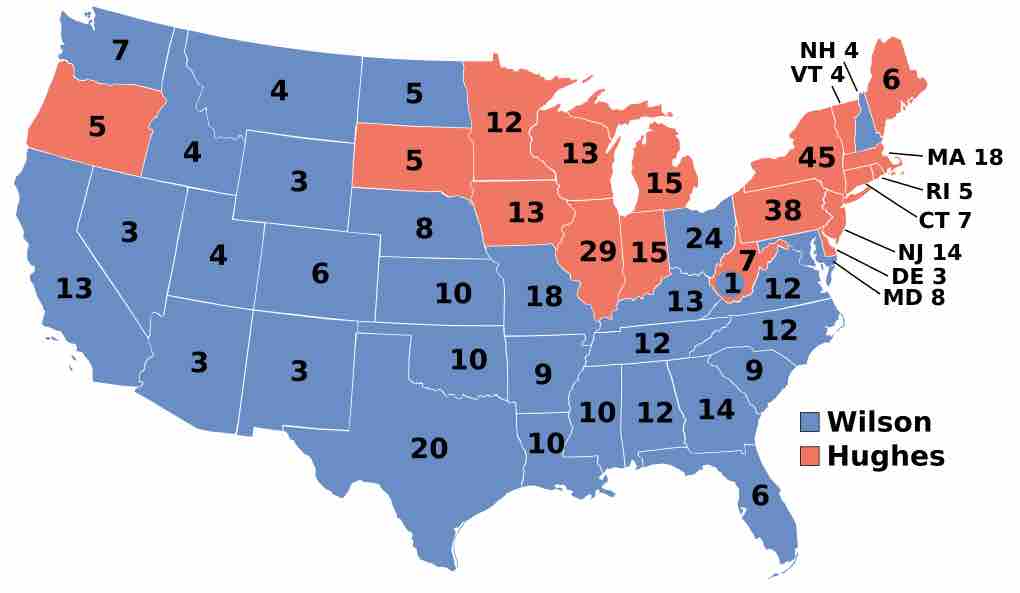The United States presidential election of 1916, which pitted incumbent Democratic President Woodrow Wilson against Republican Supreme Court Justice Charles Evans Hughes, took place while Europe was embroiled in World War I. Public sentiment in America favored the British and French forces, known as the Allies, due to the harsh treatment of civilians by the German Army, which invaded and occupied parts of Belgium and northern France. Despite this Allied sympathy, most American voters wanted to remain neutral and avoid direct involvement in the conflict.
Conventions and Nominations
Republicans
A major goal of the 1916 Republican National Convention in Chicago from June 7 to 10 was to heal the bitter split within the party that occurred during the 1912 presidential campaign. Theodore Roosevelt had split from the GOP and formed his own group, the Progressive Party, which attracted most of the liberal Republicans. William Howard Taft, the incumbent president and Roosevelt’s successor, won the 1912 Republican nomination. The split with the Progressives, however, divided the Republican vote and gave a boost to Democrat Woodrow Wilson, who defeated Taft for the presidency in 1912.
1916 Republican Convention
This photo was taken during the 1916 Republican Party National Convention at The Coliseum in Chicago.
Several candidates competed for the 1916 Republican nomination, but the party's bosses wanted a moderate who would be acceptable to both conservative and liberal factions. They turned to Supreme Court Justice Charles E. Hughes, who had served on the court since 1910 and thus had the advantage of not having publicly spoken about political issues in six years. Hughes was the only Supreme Court Justice to be nominated for president by a major political party and was joined on the ticket by former Vice President Charles W. Fairbanks, who served under Roosevelt.
Democrats
The 1916 Democratic National Convention was held in St. Louis from June 14 to 16. Given Wilson's enormous popularity within the party, he was overwhelmingly re-nominated. Vice President Thomas R. Marshall was also re-nominated with no opposition.
Progressives
The Progressive Party re-nominated former President Theodore Roosevelt, but he turned down the nomination for both personal and political reasons. Roosevelt had developed a strong dislike for President Wilson, whom he believed was allowing Germany and other warring European nations to "bully" the United States. Convinced that running again on a third-party ticket would give the election to Wilson and the Democrats, he gave his support to the Republican Hughes.
After Roosevelt’s refusal to run, the Progressive Party quickly fell apart. Most of its members returned to the Republican Party, although a substantial minority supported Wilson for his efforts to keep the United States out of World War I.
Campaigning
The Democrats built their campaign around the slogan, "He Kept Us out of War," playing on America’s desire for neutrality by highlighting Wilson’s attempts to broker peace between the European nations during his first term in office. Hughes insisted on downplaying the war issue, but still advocated a program of greater mobilization and preparedness. A Republican victory would likely mean war with the Central Powers, led by Germany, as well as with Mexico.
Wilson had successfully pressured the Germans to suspend unrestricted submarine warfare, making it difficult for Hughes to oppose Wilson's peace platform. Hughes also attacked Wilson for his support of various "pro-labor" laws, such as limiting the workday to eight hours, on the grounds that they were harmful to business interests. His criticisms gained little traction, however, especially among factory workers.
Election Result
The result was exceptionally close and the outcome was in doubt for several days. The electoral vote was one of the closest in American history. With 266 votes needed to win, Wilson took 30 states for 277 electoral votes, while Hughes won 18 states and 254 electoral votes. Wilson's peace position was likely critical in winning the western states; the key proved to be California, which Wilson won by only 3,800 votes out of nearly a million ballots cast. In the popular vote, Wilson's lead was ultimately larger, but extremely narrow. Wilson's popular vote margin of 3.1% remained the smallest attained by a victorious sitting president until 2004.

Electoral College voting results in the Presidential election of 1916
Presidential election results map. Red denotes states won by Hughes/Fairbanks, Blue denotes those won by Wilson/Marshall. Numbers indicate the number of electoral votes allotted to each state.
The total number of popular votes cast in 1916 exceeded that of 1912 by 3.5 million. The large total indicated the public's heightened interest in the campaign, in part due to states' extension of suffrage to women.